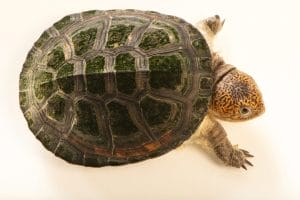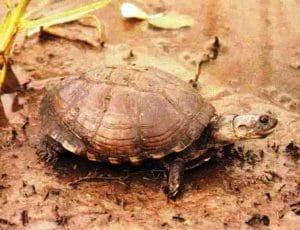Pelusios castanoides (Yellowbelly mud turtle)
Home > Turtle Database > Pelusios castanoides (Yellowbelly mud turtle)

Pelusios castanoides, known as the yellowbelly mud turtle, is a small freshwater turtle native to parts of Africa. Its name comes from its distinct yellow plastron, which contrasts with its darker carapace. These turtles are shy, semi-aquatic, and spend much of their time hidden in muddy waters.
Native To These Regions
KwaZulu-Natal (South Africa), Madagascar, MozambiqueNative Turtle Species Map – Find Turtles by Region
Scientific Classification
- Kingdom: Animalia
- Phylum: Chordata
- Class: Reptilia
- Order: Testudines
- Family: Pelomedusidae
- Genus: Pelusios
- Species: P. castanoides
Common Names
- Yellowbelly mud turtle
- East African yellow-bellied mud turtle
This Hilarious Turtle Book Might Know Your Pet Better Than You Do
Let’s be real—most turtle care guides feel like reading a textbook written by a sleep-deprived zookeeper.
This one’s not that.
Told from the snarky point of view of a grumpy, judgmental turtle, 21 Turtle Truths You’ll Never Read in a Care Guide is packed with sarcasm, sass, and surprisingly useful insights.
And hey—you don’t have to commit to the whole thing just yet.
Grab 2 free truths from the ebook and get a taste of what your turtle really thinks about your setup, your food choices, and that weird plastic palm tree.
It’s funny, it’s honest, and if you’ve ever owned a turtle who glares at you like you’re the problem—you’ll feel seen.
Identification
Description
This turtle has a domed, dark brown to black carapace and a bright yellow plastron. The skin is usually brownish-gray with some yellow tones on the limbs and neck. Adults are generally 15–18 cm in length.
Sexual Dimorphism
Males usually have longer tails and slightly concave plastrons. Females tend to be larger overall.
Check more turtles from the Pelusios genus
Native Origin and Distribution
Geographical Range
Pelusios castanoides is found in eastern and southeastern Africa, including Madagascar, Tanzania, Mozambique, and parts of South Africa.
Preferred Habitat
They live in slow-moving or still freshwater habitats like swamps, marshes, ponds, and floodplains. Muddy or sandy bottoms with vegetation are ideal for hiding and foraging.
Behavior
Feeding Habits
They are omnivores. Their diet includes insects, worms, snails, small fish, and aquatic plants. They scavenge when needed.
Predators
Birds, large fish, and crocodiles are known to prey on them. Hatchlings are more vulnerable and also face threats from snakes and mammals.
Reproduction
Breeding Season
Breeding occurs mostly during the rainy season, which varies by region.
Reproductive Method
They lay eggs in sandy or soft soil near water. Clutches usually contain 6–12 eggs, and incubation can last 2–3 months depending on temperature.
Conservation
Extinction Status
Listed as Least Concern on the IUCN Red List.
Threats
Habitat destruction, pollution, and illegal pet trade are the main concerns. In some areas, water bodies are drying due to human activity.
Conservation Measures
Protected areas and breeding studies are helping. Some local laws regulate their capture and trade.
Economic Importance
They are sometimes kept as pets. In rural areas, locals may hunt them for food, though this is not widespread.
Interesting Facts
They can survive dry periods by burrowing into mud and going dormant.
Like other side-necked turtles, they fold their necks sideways instead of pulling them straight into the shell.

About Author
Muntaseer Rahman started keeping pet turtles back in 2013. He also owns the largest Turtle & Tortoise Facebook community in Bangladesh. These days he is mostly active on Facebook.














